On This Page
Crape Myrtle Tree and Shrub Care Tips
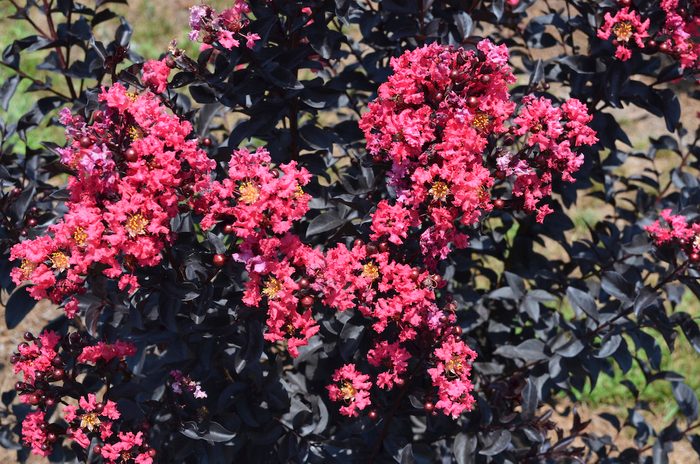
- Botanical name: Lagerstroemia spp.
- Common names: Crape myrtle, crepe myrtle, crapemyrtle, crepe-myrtle
- Hardiness zones: 6 to 10
- Size: 3 to 30 feet
- Soil: Moist, well-draining
- Water needs: Moderate
- Light needs: Full sun
- Flower colors: White, pink, magenta, red
- Foliage: Deciduous, some foliage color in spring and fall
- Attracts: Bees, birds
This fast-growing (up to 5 feet per year) woody plant flowers all summer long, making crape myrtle a popular garden favorite. “Specimen trees can be great for shade in the summer,” says Tracy Harrison, Nursery Production Planning Manager at Monrovia. “Plenty of shrubs and groundcovers thrive under them and they can really anchor a landscape.” There are smaller shrub types for smaller garden spaces, too.
In the U.S., you’ll find a couple of species available, depending on your location, with multiple cultivars and varieties. The most common is Indian crape myrtle, L. indica. This species does well in heat, humidity, and drought.
Japanese crape myrtle, L. fauriei, is generally larger. Both may freeze to the ground in zones 6 and 7 winters, but usually regrow in the spring.
Is Crape Myrtle a Bush or Tree?
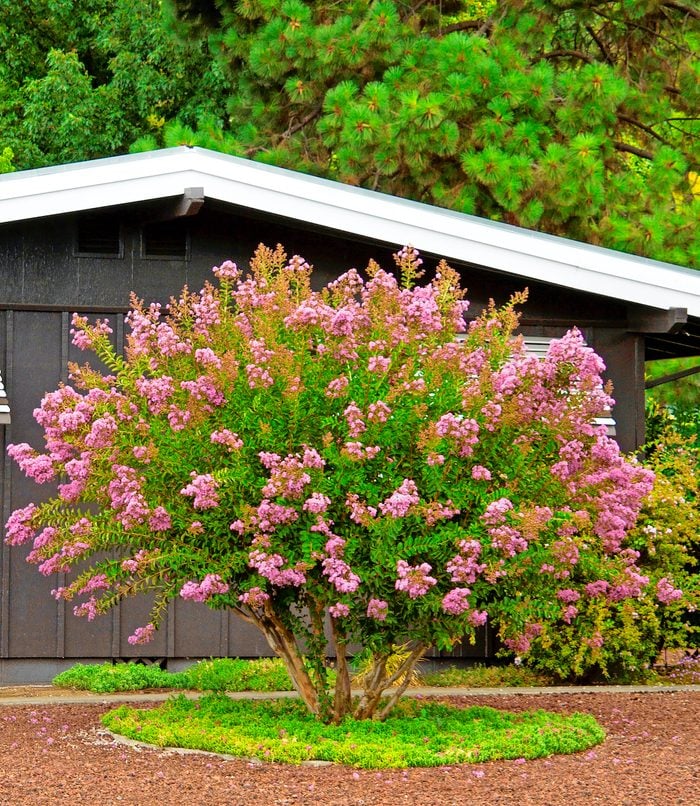
With such a wide array of sizes available, crape myrtle can be used as either a bush or a tree. “Varieties that can reach at least 15 to 20 feet are the best to tree form,” Tracy advises. “First, decide if you would like a single or multi-trunked form. From there it’s a matter of thinning and training to the desired form. Remove suckers and crossing branches up to at least head high to get that nice ‘see through’ look.”
If that seems like too much work, try using this plant as a bush or shrub instead. “I like the compact shrub-like crape myrtle, personally,” shares Tracy. “They’re a lot less work, as they’re expected to be dense plants and can be sheared back in late winter and other times during the growing season.”
Where and How to Plant Crape Myrtle
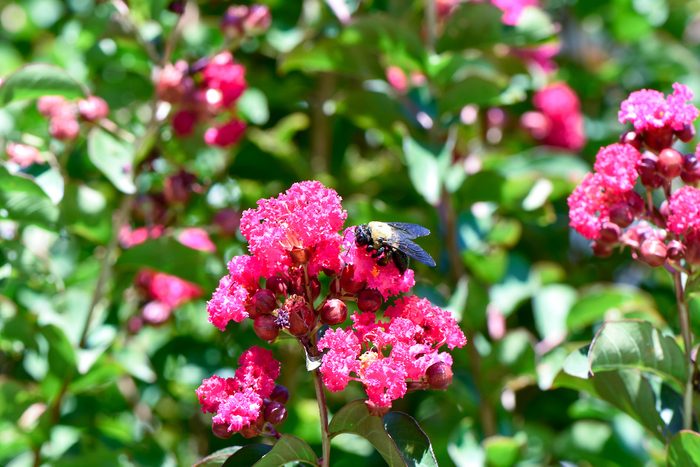
This flowering beauty needs lots of sunlight to thrive. During the growing season, it’s fairly water-hungry, but it prefers well-drained soil at all times. Tracy suggests applying a complete slow-release fertilizer just as they’re breaking dormancy in the spring.
Can You Grow Crape Myrtle in Containers?
Plant crape myrtle anywhere that receives lots of sunlight, including in pots. Choose smaller varieties for containers, and display them around the patio or pool for pops of bright summer color. You can also use smaller or intermediate size types as foundation plantings.
How to Prune Crape Myrtle
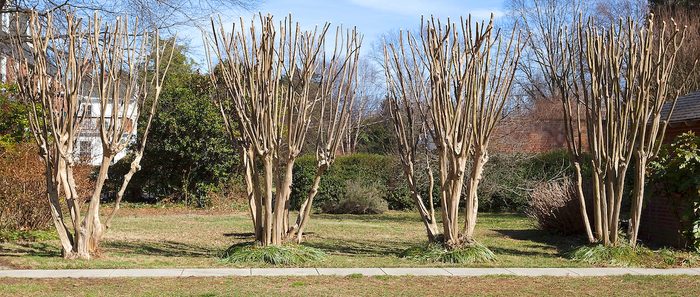
There’s a lot of disagreement out there on the proper way to prune a crape myrtle. Some prune crape myrtles back heavily each year, trimming all branches and leaving only an unsightly stump. While it’s true that crape myrtles flower on new growth, there’s no real need to prune them so heavily, and there’s a reason that some horticulturalists jokingly call this “crape murder”.
“Crape myrtles are extremely tough and can take pruning well,” Tracy notes. “I prefer to limb and train up a natural canopy on the tall trees. Pruning should occur in the late winter prior to the plant breaking dormancy. Thin any crossing branches, suckers, or unwanted growth that are not needed for the desired structure. If the plant has plenty of room, then only the prior year’s seed pods should be pruned out.”
Remember that pruning any plant opens it up to the possibility of disease or pests, just like a cut on human skin. Prune sparingly and carefully, following Tracy’s directions: “Make a cut close to the trunk or larger branch that the unneeded branch is attached to. Just try not to cut into the branch collar so the tree can heal as quickly as possible.”
Crape Myrtle Pests and Diseases
While crape myrtles are generally fairly easy to grow, Tracy recommends watching out for a few pests and diseases
- Powdery mildew: Some varieties are more resistant than others, so if you experience this fungus often in your garden, look for those bred to resist it.
- Foliar leaf spots: These can occasionally cause leaf drop, but don’t usually affect the overall plant health.
- Ambrosia beetles: If you see toothpick-like sawdust on the trunk or branches, you likely have an infestation. Treatment requires aggressive use of pesticides, so it may be best to cut the tree down instead.
- Aphids: Black mildew grows on aphid honeydew, and can be unsightly. Try removing aphids with a strong squirt from the garden hose, or use insecticidal soap.
Top Crape Myrtle Varieties for Your Garden
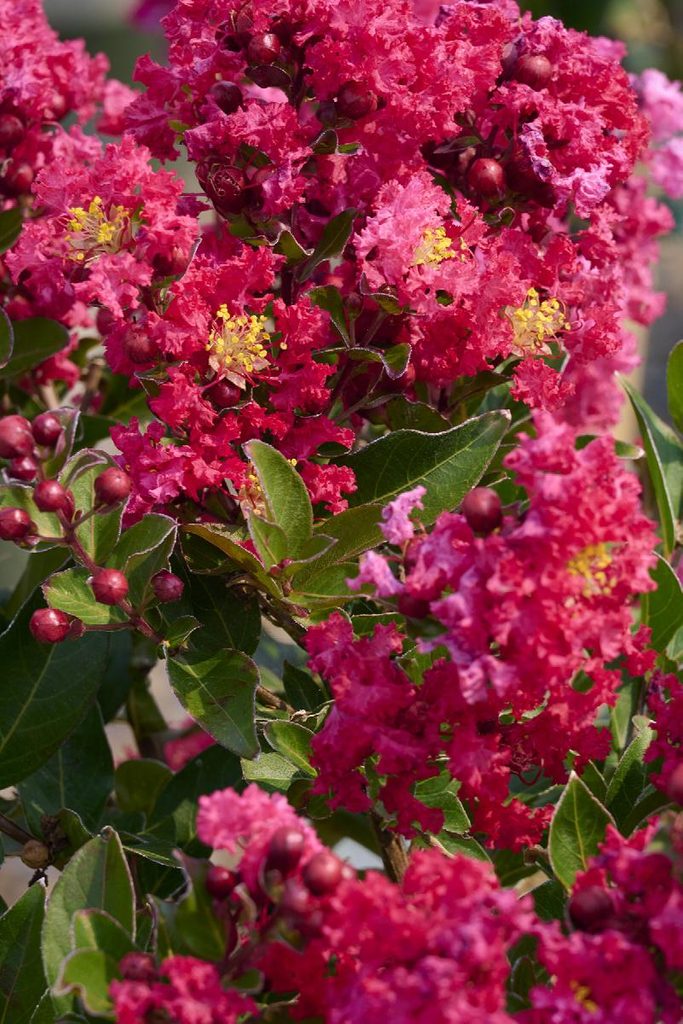
Compact bush-types have a lot of advantages, including some with beautiful colors on the new spring foliage. “This trait alone is great for a foundation plant. but with these you get the added benefit of abundant flowers in many colors that often contrast against the backdrop of the foliage,” raves Tracy. “At Monrovia we have the Summerlasting series that I love. My favorite is a glossy red new growth compact variety named Summerlasting Strawberry.”
For tree-form crape myrtles, choose medium or large varieties like Dynamite, Muskogee, or Natchez. In zone 6, try Red Rocket for its cold-hardiness properties.
About the Expert
Tracy Harrison is the Nursery Production Planning Manager at Monrovia’s Cairo, Georgia, nursery location. He studied horticulture at the University of Georgia, and has been a Monrovia Craftsman for 30 years.
Sources
- Plantingtree.com – Choosing the right crape myrtle tree
- North Carolina State Extension – Ambrosia beetle
- University of Florida Institute of Food and Agricultural Sciences
- Monrovia
Why Trust Us
For nearly 30 years, Birds & Blooms, a Trusted Media Brand, has been inspiring readers to have a lifelong love of birding, gardening and nature. We are the #1 bird and garden magazine in North America and a trusted online resource for over 15 million outdoor enthusiasts annually. Our library of thousands of informative articles and how-tos has been written by trusted journalists and fact-checked by bird and garden experts for accuracy. In addition to our staff of experienced gardeners and bird-watchers, we hire individuals who have years of education and hands-on experience with birding, bird feeding, gardening, butterflies, bugs and more. Learn more about Birds & Blooms, our field editor program, and our submission guidelines.
On This Page
Asian Jumping Worms vs Earthworms
![Invasive Earthworm Amynthas Agrestis [tentative Id]](https://www.birdsandblooms.com/wp-content/uploads/2024/04/6953504495_465c02c8f7_o.jpg?fit=700%2C1024)
As an invasive species, jumping worms are harmful because they consume organic matter and degrade the topmost layer of soil. This can make the soil non-conducive to native plant growth and often leaves it inhospitable to anything except for invasive plants. Soil these worms have infested is often granular, with a consistency similar to that of coffee grounds.
The easiest way to recognize jumping worms vs earthworms is by their movement. They move quickly, slithering and thrashing like snakes. In addition, be on the lookout for key differences in appearance. Jumping worms have a brownish gray color, while earthworms are pink or red; their bodies are firm, rather than floppy.
Got holes in your leafy greens? You have cabbage worms.
How to Get Rid of Jumping Worms
![Invasive Earthworm Amynthas Agrestis [tentative Id]](https://www.birdsandblooms.com/wp-content/uploads/2024/04/6807385430_5b962ddc40_o.jpg?fit=700%2C1024)
Gardening expert Melinda Myers says, “Unfortunately, there is no magic cure for jumping worms. Collect and dispose of them as they are found. Toss them into a clear plastic bag to kill them or into a container of isopropyl alcohol before adding them to the trash.
Many gardeners use the mustard test to determine their presence and drive them to the soil surface: Mix 1/3 cup ground hot yellow mustard seed into a gallon of water, then drench the garden area with this mixture. This drives these worms (and other earthworms) to the soil surface, where you can remove and kill the jumping worms.
Heat is another option. The adults, eggs and cocoons are killed when exposed to temperatures over 104 degrees for three days. This is ineffective for garden beds, as the worms move away from the heat, but you can use the sun’s power to kill jumping worms in mulch, compost and topsoil.
Spread a 6-inch layer of these materials on a sheet of plastic placed in a sunny location. Wrap and secure the plastic around the mulch, compost or soil. Check the temperature to make sure it’s above 104 degrees for at least three consecutive days.
BotaniGard has been found to provide some control. As always, read and follow label directions.”
Here’s how to stop the tomato hornworm from damaging your tomatoes.
Prevent Asian Jumping Worm Infestations
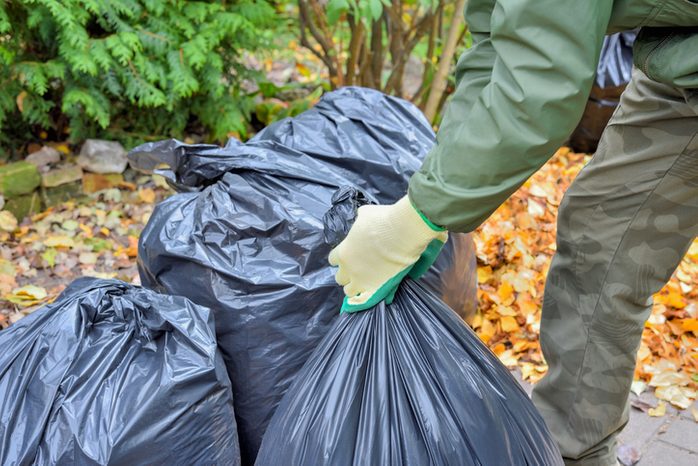
If possible, you want to keep these invasive worms from moving into your yard in the first place.
Melinda says, “You can prevent jumping worm infestations and keep them from spreading by cleaning tools and shoes when moving from one garden to another. Don’t share plants, and ask mulch, compost and topsoil providers how they manage jumping worms before purchasing.”
Next, learn how to control caterpillars that are garden insect pests.
About the Expert
Melinda Myers is the official gardening expert for Birds & Blooms. She is a TV/radio host, author and columnist who has written more than 20 gardening books. Melinda earned a master’s degree in horticulture from the University of Wisconsin-Madison.
Sources
- PennState Extension, “Look Out For Jumping Earthworms!“
- Cornell Cooperative Extension Warren County, “Invasive Asian Jumping Earthworms“
- Wisconsin Department of Natural Resources, “Jumping worms“
Why Trust Us
For nearly 30 years, Birds & Blooms, a Trusted Media Brand, has been inspiring readers to have a lifelong love of birding, gardening and nature. We are the #1 bird and garden magazine in North America and a trusted online resource for over 15 million outdoor enthusiasts annually. Our library of thousands of informative articles and how-tos has been written by trusted journalists and fact-checked by bird and garden experts for accuracy. In addition to our staff of experienced gardeners and bird-watchers, we hire individuals who have years of education and hands-on experience with birding, bird feeding, gardening, butterflies, bugs and more. Learn more about Birds & Blooms, our field editor program, and our submission guidelines.
On This Page
Common Yellowthroat Song
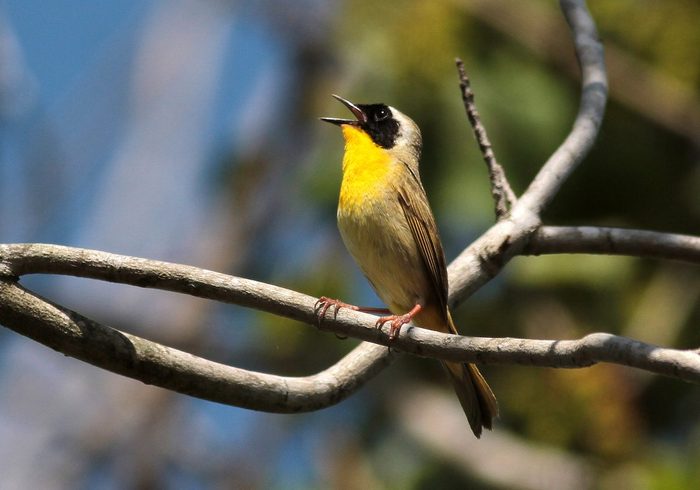
Step into your backyard on a summer morning, and you’re likely to be greeted by a chorus of chirps and trills. Robins are carol cheerily cheer-up, and chickadees scold chickadee-dee-dee-dee. Suddenly, a different tune stands out, a snappy wichity-wichity-wichity. A search toward the sound along an unruly hedge reveals a common yellowthroat.
Often, it’s the sound of this colorful warbler rather than its bold black and yellow plumage that you first notice. Common yellowthroats are not rare but they are elusive, mostly staying within the protective cover of shrubs. What a treat to hear and see one!
The song is also sometimes described as which-is-it, which-is-it, which-is-it. Also, listen for a sharp chip when the bird is hidden in a brambly bush or tangle of low shrubs and grass.
Bird sounds courtesy of The Cornell Lab of Ornithology
What Does a Common Yellowthroat Look Like?
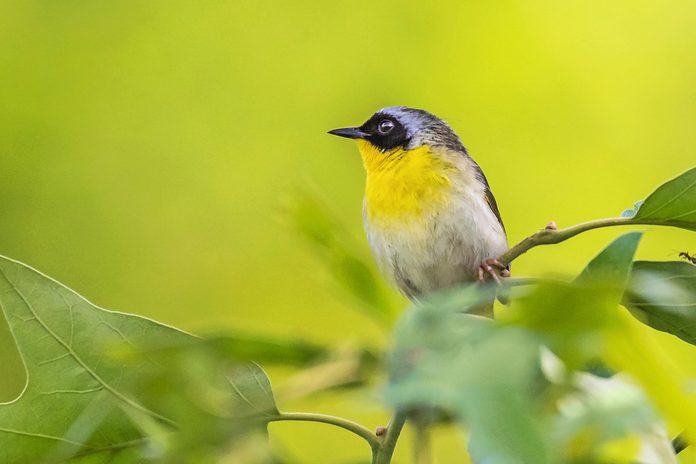
As their name suggests, a mature male common yellowthroat has a distinctive bright yellow throat. Sometimes nicknamed “yellow bandit” due to its prominent black mask, it’s similar in size to a sparrow, about five inches long with a medium-long tail, olive back, and sharp beak. Females also have a yellow throat, though paler, with a brownish head and back and no mask.
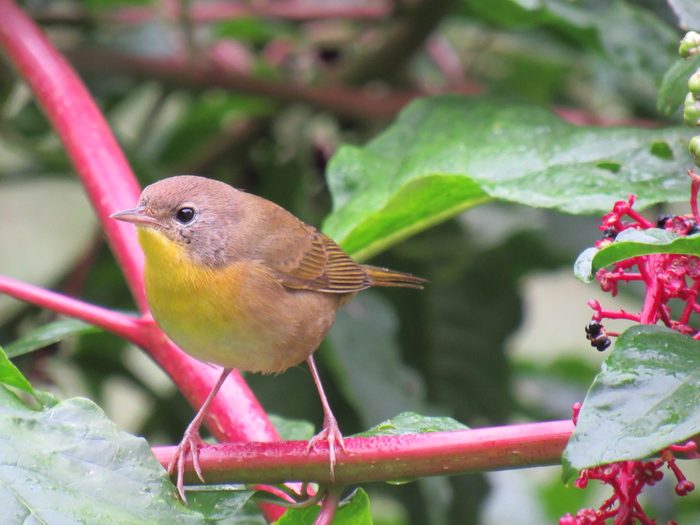
“The first time I saw photo of a male common yellowthroat, I knew that this was a bird I could identify without having to figure out whether it has an eye ring or faint wing bars, or some other minute detail,” says Pam Otto, a naturalist with the St. Charles, Illinois Park District who teaches birding classes and leads birding walks.
“His black mask and yellow throat are so bold and unique that the species is unmistakable. That is, if you can see him. The other thing I love about these birds is their elusiveness. They’re often heard, but seeing them is another matter entirely. I always feel lucky if I’m able to spot a common yellowthroat singing,” she says.
Range and Habitat
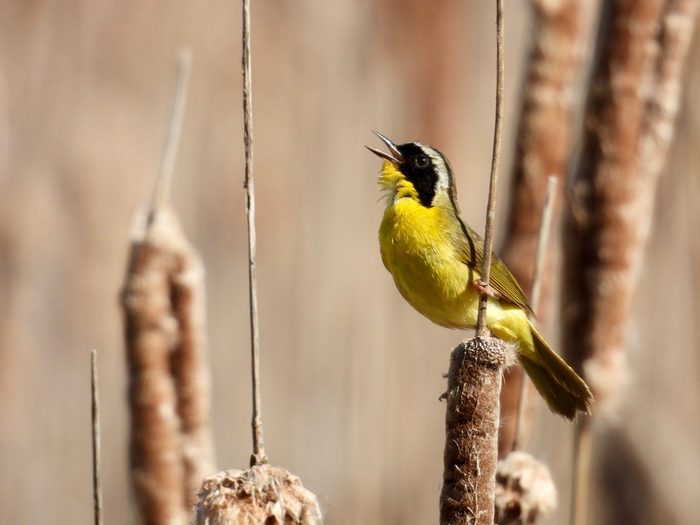
Common yellowthroats breed in the low, dense, tangled vegetation around wetlands and riparian areas across North American, though you can sometimes spot them along the edges of drier upland forests and hedgerows. Although they try to remain out of sight, you might see one flit out of the reeds to snatch a bug, perch atop a cattail to call out its territory, or simply because its curious about an unfamiliar sound.
As summer wanes, yellowthroats migrate, traveling at night, to similar marshy habitats in the southern United States and as far south as Central America.
Common Yellowthroat Nesting Habits
“Common yellowthroats are the only New World warbler that actually nest in marshes,” says Pam. “Prothonotary warblers can be found in tree cavities in swamps, but marshes typically are treeless. Yellowthroats usually nest in low vegetation or on the ground, so a lack of trees is not an issue for them.”
The males arrive first in the spring, loudly proclaiming their spot and to attract a mate, though the females are often unfaithful after courtship. After mating, a female weaves a well-hidden, cup-shaped nest out of grasses, leaves and sedges, sometimes with a roof. She then lays one to six white, speckled eggs. The chicks hatch in just 12 days.
Both the male and the female feed the chicks, which fledge in eight to 12 days.
What Do Common Yellowthroats Eat?
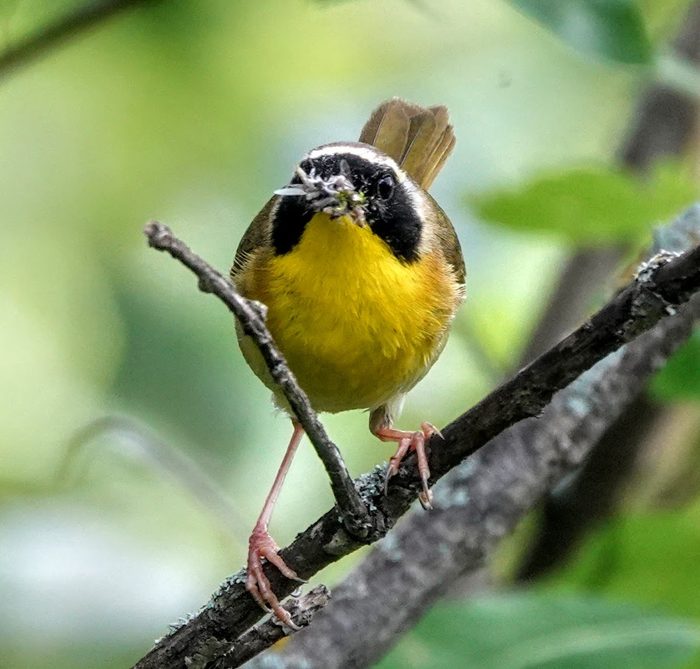
Like other warblers, the common yellowthroat primarily eats insects, spiders and insect larvae. They pluck bugs off low vegetation and sometimes from the air, but they’ll also snack occasionally on flower nectar, bark, branches, and fruit, especially as winter and bugs are in short supply.
While not typically attracted to a feeder, they might pass through your backyard while migrating if the yard is big enough (at least a half-acre) and not immaculately manicured.
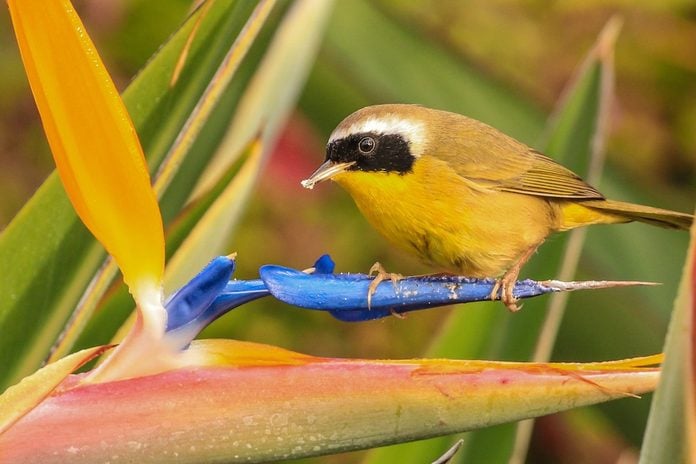
“Most yards are too neat or too small to be of interest to common yellowthroats, but if someone has a large piece of property, ideally near a wetland, and they have lots of sedges, grasses and other plants that have dense, tangled growth habits, the common yellowthroats will find them,” says Pam.
About the Expert
Pam Otto is an outreach ambassador and naturalist with the St. Charles Park District in St. Charles, Illinois. She has taught birding classes and led birding walks for 25 years.
Sources
- All About Birds – common yellowthroat
- National Audubon Society – common yellowthroat
- Smithsonian’s National Zoo – common yellowthroat
- Interview with Pam Otto
Why Trust Us
For nearly 30 years, Birds & Blooms, a Trusted Media Brand, has been inspiring readers to have a lifelong love of birding, gardening and nature. We are the #1 bird and garden magazine in North America and a trusted online resource for over 15 million outdoor enthusiasts annually. Our library of thousands of informative articles and how-tos has been written by trusted journalists and fact-checked by bird and garden experts for accuracy. In addition to our staff of experienced gardeners and bird-watchers, we hire individuals who have years of education and hands-on experience with birding, bird feeding, gardening, butterflies, bugs and more. Learn more about Birds & Blooms, our field editor program, and our submission guidelines.
On This Page
Rugosa Rose Care and Growing Tips
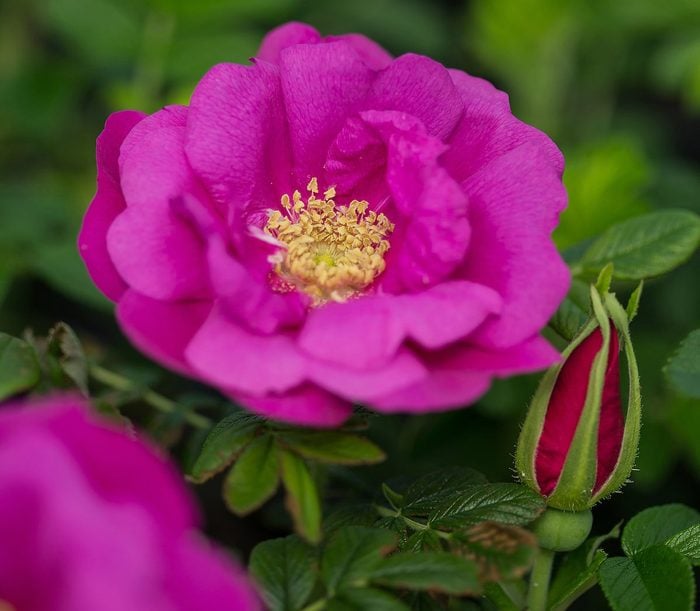
- Common names: rugosa rose, beach rose
- Botanical name: Rosa rugosa and hybrids
- Hardiness zones 3 to 10
- Light needs: Full sun
- Soil: Moist, well-draining
- Size: 3 1/2 feet to 6 tall and wide
Rugosa rose is a tough and adaptable shrub rose native to Asia. Its name Rugosa translates in Latin as “wrinkled” because of its leathery, dark green foliage. The plants can be heavily thorned. The blooms, ranging from white to magenta and rarely yellow, can be single or double. They are often quite fragrant, usually displaying an open center full of bright yellow stamens.
Indiana-based rosarian Teresa Byington, who consults for the American Rose Society, says rugosas are so resilient that there’s one for nearly every sunny garden.
While they will grow even in sandy coastal regions, a rugosa rose prefers acidic to neutral, moist, and well-draining soils in full sun. Rugosas can tolerate significant drought and even salt spray. Deer may nibble the flowers, but won’t do much damage to the well-armed stalks.
Their most profuse bloom is during early summer, but Teresa says deadheading will encourage rebloom through the growing season.
She appreciates the spicy-sweet fragrance of their flowers, their bright fall hips, and the rugged disposition of their disease-resistant foliage.
Unlike many roses, rugosas prefer a hands-off approach. She says, ” they do not respond well to any kind of sprays,” making them “excellent choices for the organic gardener.”
Pruning Rugosa Roses
As a group, roses are notorious for needing regular pruning, but your rugosa rose will need very little pruning.
“Rugosas do not need the type of pruning many roses need, but can be pruned to control size,” Teresa says. She recommends pruning out dead wood and oldest canes from the base in late fall or very early spring. If overgrown, they are tough enough even to handle being pruned down to a foot tall, she says.
Are Rugosa Roses Invasive?
The plants are easy to grow and can spread by seeds and suckering, making a fast-growing hedge or barrier. They have become invasive in Maine, so check your state’s invasive plant list before planting, especially near wild areas.
Rugosa Rose Wildlife Benefits
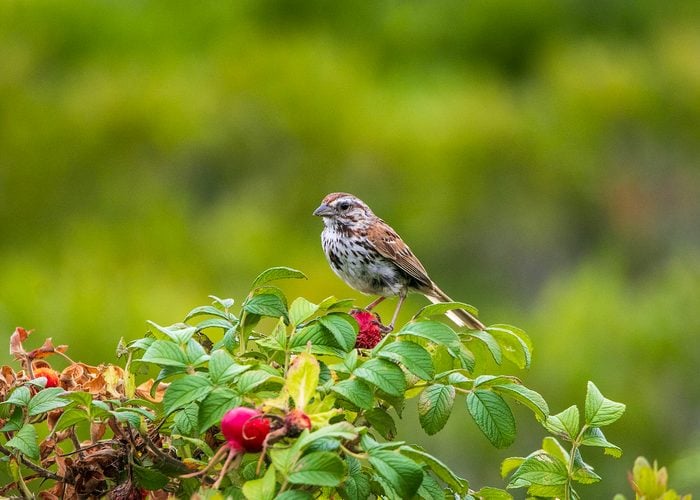
Bees love their flowers and birds devour their seed heads, called hips. Their dense branches offer small birds winter shelter, too.
Rugosa Rose Hips
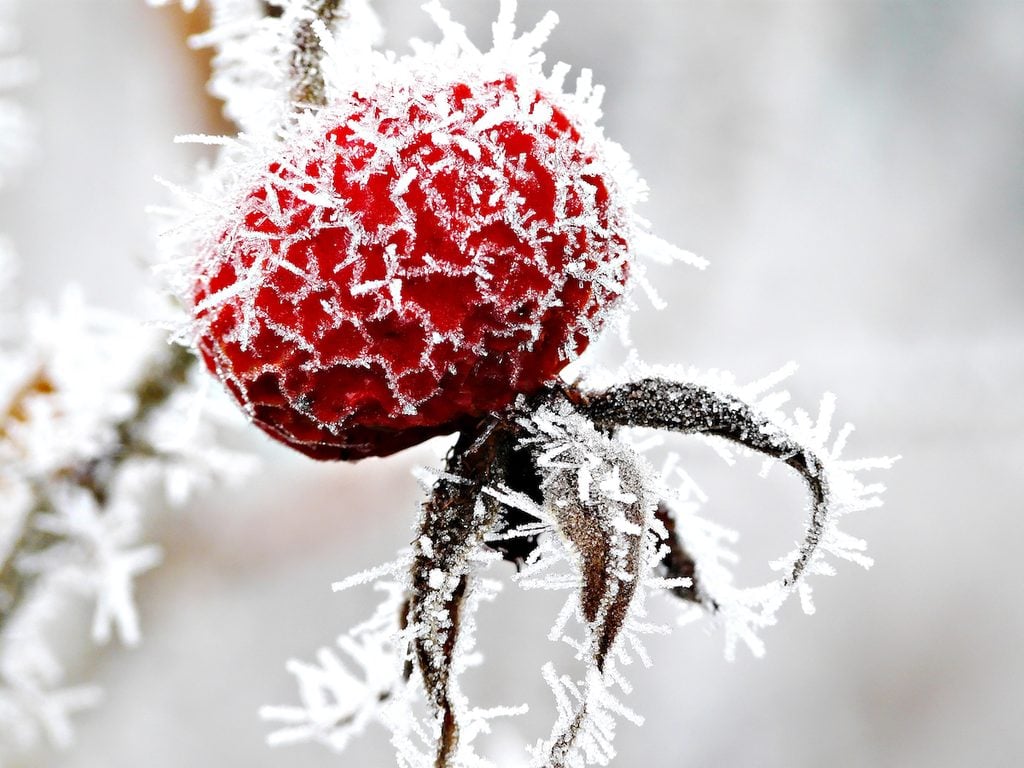
Thanks to their one-inch orange-red hips in fall, rugosas are sometimes called “sea tomatoes.”
Rugosa rose hips have more vitamin C than oranges and can be used to make a delicious tea, jam or jelly. Rugosa rose hips are said to be the most delicious in the rose family.
About the Expert
Sources
- American Rose Society
- Maine Department of Agriculture, Conservation & Forestry
- The Garden Diary
- Missouri Botanical Garden
Why Trust Us
For nearly 30 years, Birds & Blooms, a Trusted Media Brand, has been inspiring readers to have a lifelong love of birding, gardening and nature. We are the #1 bird and garden magazine in North America and a trusted online resource for over 15 million outdoor enthusiasts annually. Our library of thousands of informative articles and how-tos has been written by trusted journalists and fact-checked by bird and garden experts for accuracy. In addition to our staff of experienced gardeners and bird-watchers, we hire individuals who have years of education and hands-on experience with birding, bird feeding, gardening, butterflies, bugs and more. Learn more about Birds & Blooms, our field editor program, and our submission guidelines.
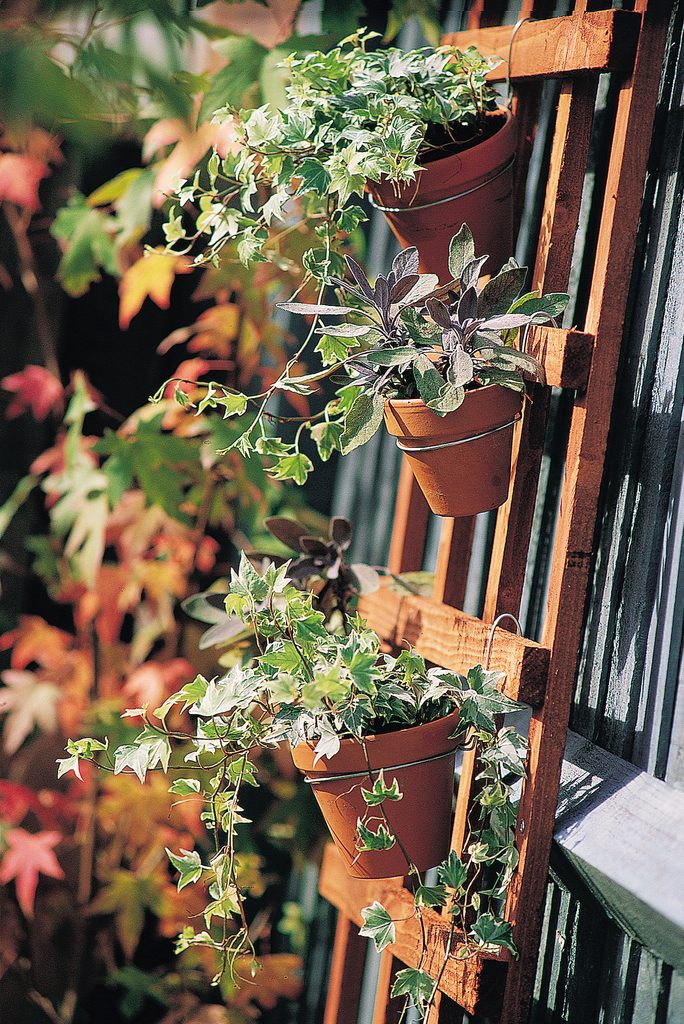
Have some old clay pots lying around? Brighten up a bare fence or wall with this simple pot trellis. You can change the look as often as you like—just unhook the pots and pop in fresh plants.
Materials:
- Trellis
- Clay pots
- Galvanized Wire
- Wire Cutters
- Pliers
Step-By-Step Instructions:
Step 1
You can build a trellis yourself with leftover scrap wood using nails to hold it together, or you can buy a trellis to suit the site or cut one to fit. You may wish to stain or paint it with exterior paint first. Then place the trellis in its spot, making sure the horizontal bars are sturdy enough to hold the weight of potted plants.
Step 2
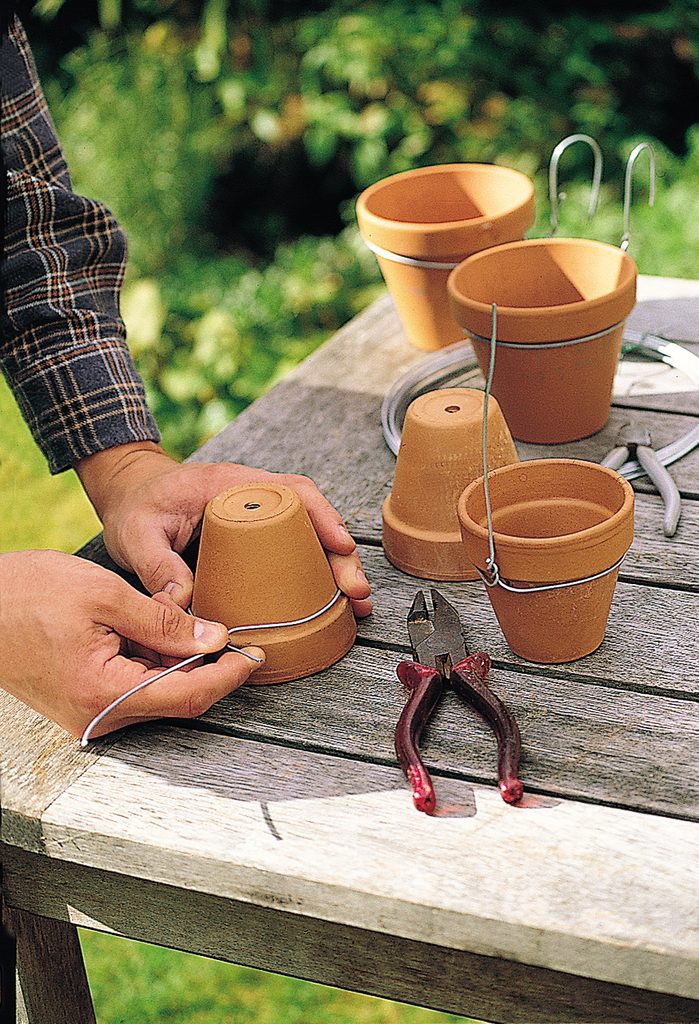
To fashion a pot loop, bend a length of galvanized wire to fit snugly beneath each pot rim.
Step 3
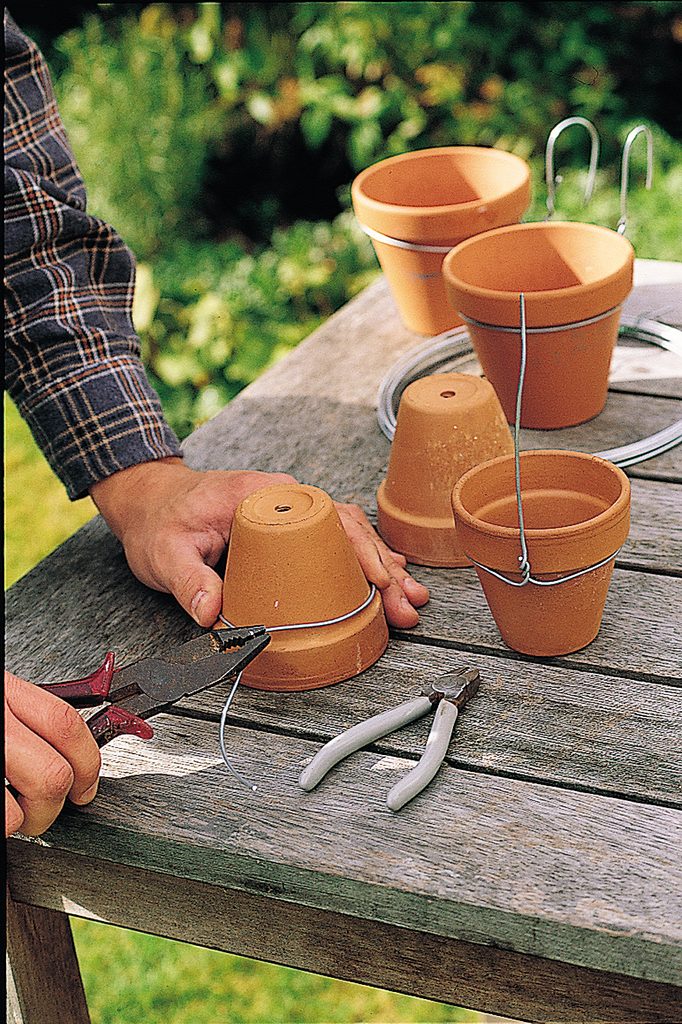
Twist one end of the wire over itself and pinch tight with pliers, leaving one long end free for hanging.
Step 4
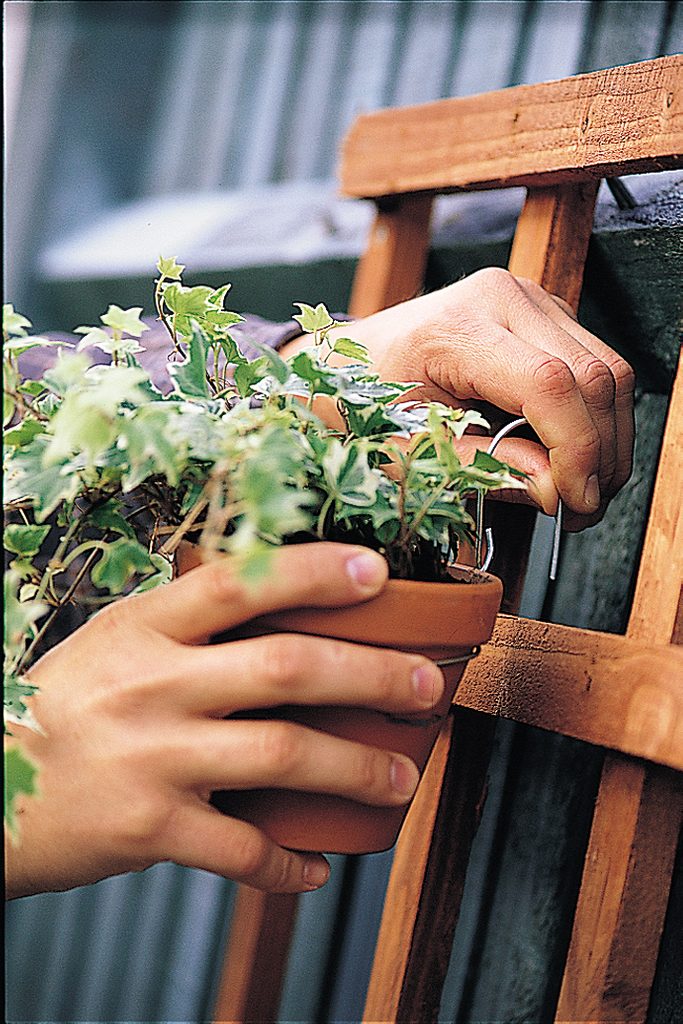
Bend the long end of the wire to make a hook that fits snugly over a horizontal piece of trellis. Add as many pots to the trellis as you like, and add plants to suit your style!
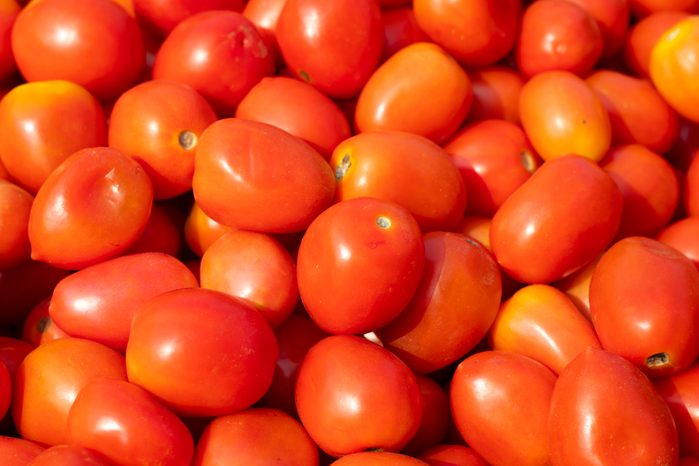
Summer is the sweetest season for the tomato lover, but with so many types and varieties available, it can be hard to know which ones are best for your garden. Terms like ‘heirloom’ and ‘hybrid’ are often used to describe tomato varieties, but what do they mean and is one type better than the other? Below we explore the pros and cons of both hybrid and heirloom tomatoes and spotlight six outstanding varieties.
Discover the worst mistakes you’re making with your tomato garden.
On This Page
Heirloom Tomato Pros and Cons

- Pre-date 1950, have often been passed down within families or communities
- Are open-pollinated which means they are pollinated naturally by wind or insects
- Saved seeds produce the exact same tomato from year to year
- Come in a wide range of shapes, sizes, and colors
- Are known for having exceptional flavor
- Generally producer fewer tomatoes per plant
- May be more prone to tomato diseases, but this also depends on cultural factors like soil fertility, spacing, and variety selection
- Heirloom tomatoes are often later to mature than hybrid varieties
Hybrid Tomato Pros and Cons
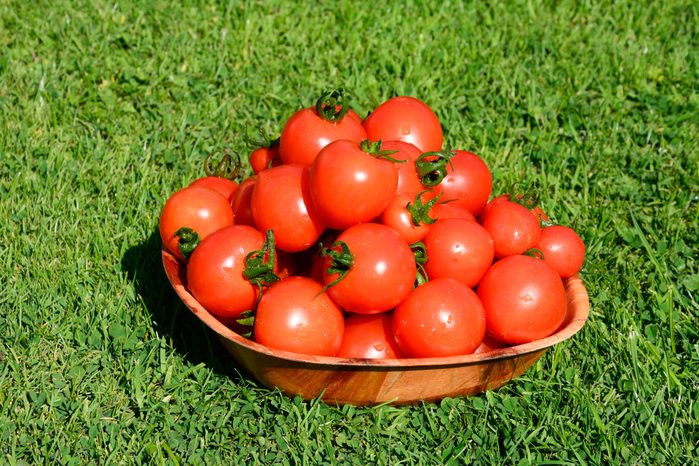
- Are the product of two different parent plants that have been cross-pollinated under controlled conditions
- Seeds saved from hybrid tomatoes aren’t stable and won’t produce the same tomatoes the following year
- Hybrids are bred to have improved traits like disease resistance, earlier maturity, higher yields, or better uniformity
- Typically perform and yield better under environmental stresses like drought
- Many hybrid varieties are early to yield making them a reliable choice for short season gardeners
Hybrid vs. Heirloom Tomatoes
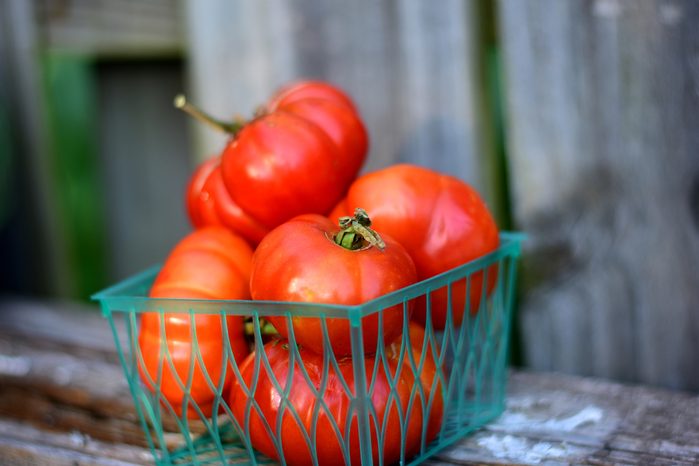
Both types of tomatoes offer advantages to the gardener. Craig LeHoullier, the author of Epic Tomatoes and the co-leader of the Dwarf Tomato Breeding Project has spent decades growing hundreds of heirloom varieties in his garden. “I love heirlooms for their ability to grow true to type from seed, their storied histories, and the incredible diversity of fruit sizes, shapes, colors, and flavors,” he says. “With so many choices—heirlooms and hybrids—it’s up to the gardener to pick appealing varieties, grow a selection, and see how they do in their region.”
Psst—this is the right way to ripen green tomatoes.
Are Heirloom Tomatoes Organic?
Heirloom tomatoes can be grown organically or conventionally, depending on the goals of the gardener. To be considered organic, tomato plants must grown without the use of synthetic pesticides and fertilizers.
Basic principles of organic gardening include building soil, providing ideal growing conditions, and using natural solutions to pest and disease issues.
Stop the tomato hornworm from damaging your tomatoes.
Are Hybrid Tomatoes GMO?
Hybrid tomatoes are often confused with GMO varieties, but they are not the same thing. Hybrid tomatoes are the result of cross-pollination and have not been genetically engineered. GMO crops contain genes from other species.
The Best Heirloom and Hybrid Tomato Varieties
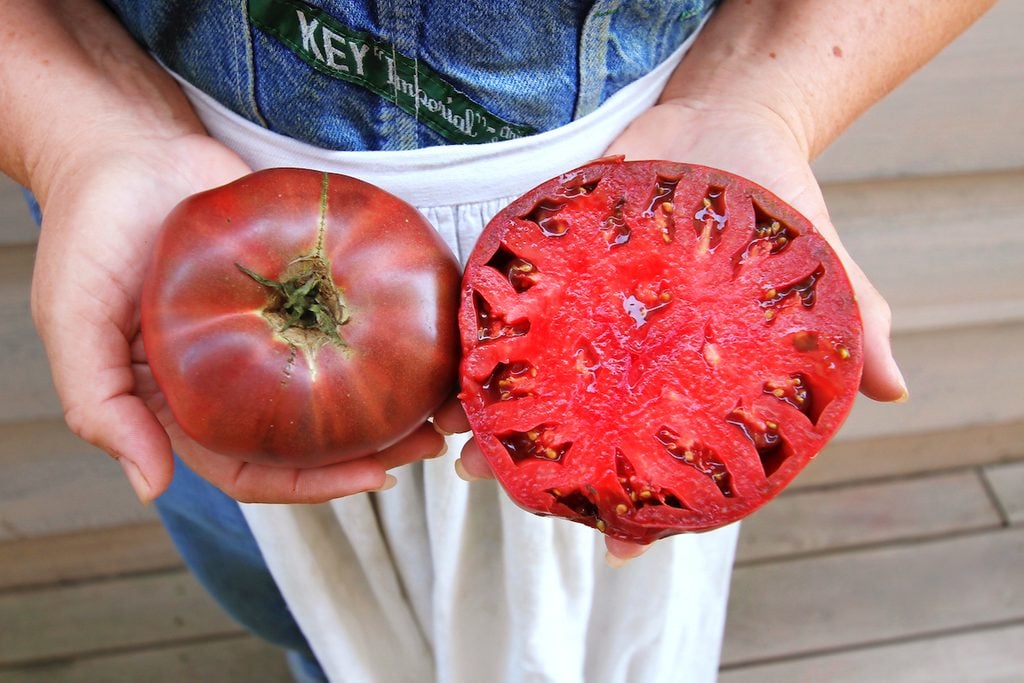
To help jump-start your tomato garden, we’ve gathered six outstanding heirloom and hybrid varieties. Find them in your favorite seed catalog or at your local nursery.
Heirloom Tomatoes to Grow
- Cherokee Purple – Craig played an important role in not only preserving this treasured heirloom but also in making the seeds available to gardeners around the world. “It never fails to excel in vigor, yield, and flavor, and the dusky rose color certainly catches the eye,” he says.
- Lillian’s Yellow – This potato-leaved heirloom variety produces a bumper crop of large yellow fruits perfect for summer sandwiches. “The flavor is simply incredible,” says Craig.
- Brandywine – Brandywine is perhaps the most widely grown heirloom tomato beloved for its jumbo-sized richly flavored fruits that can weigh over one pound.
- Also try Black Cherry, Big Rainbow, or Costoluto Genovese.
Hybrid Tomatoes to Grow
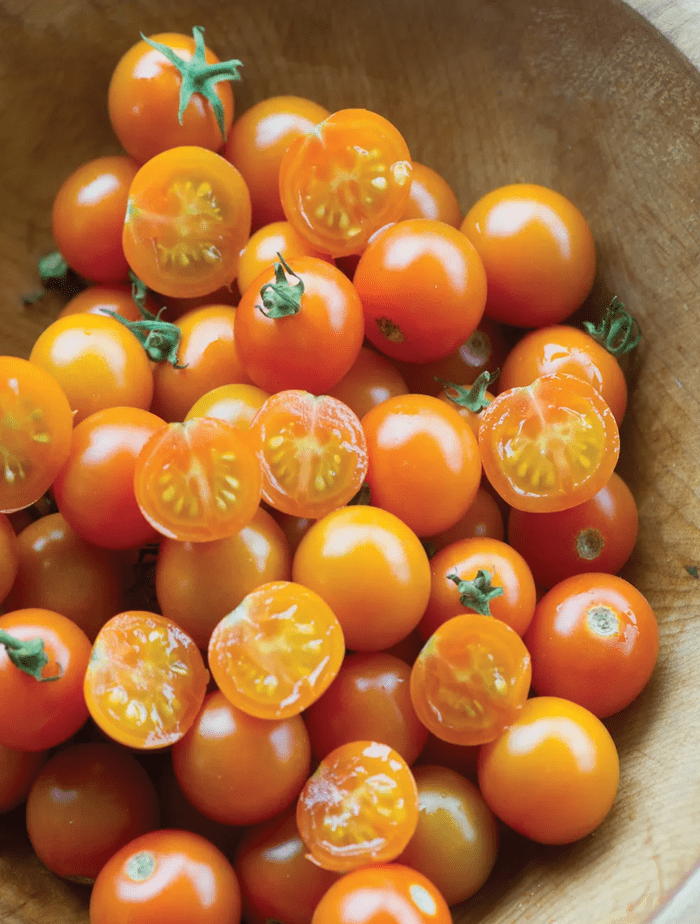
- Sungold is one of the most popular hybrid cherry tomato varieties grown by gardeners and for good reason. “There simply is no tomato with the particular complexity of flavor that Sungold possesses,” says Craig. “It’s truly addictive!”
- Lemon Boy – This reliable yellow hybrid produces delicious medium-sized fruits with a pleasing balanced flavor.
- Galahad is an award-winning hybrid beefsteak with medium-large, bright red fruits. It offers excellent resistance to early blight as well as many other common tomato diseases.
- Also try Mountain Magic, Defiant, or Juliet.
Which Tomatoes Are Best?
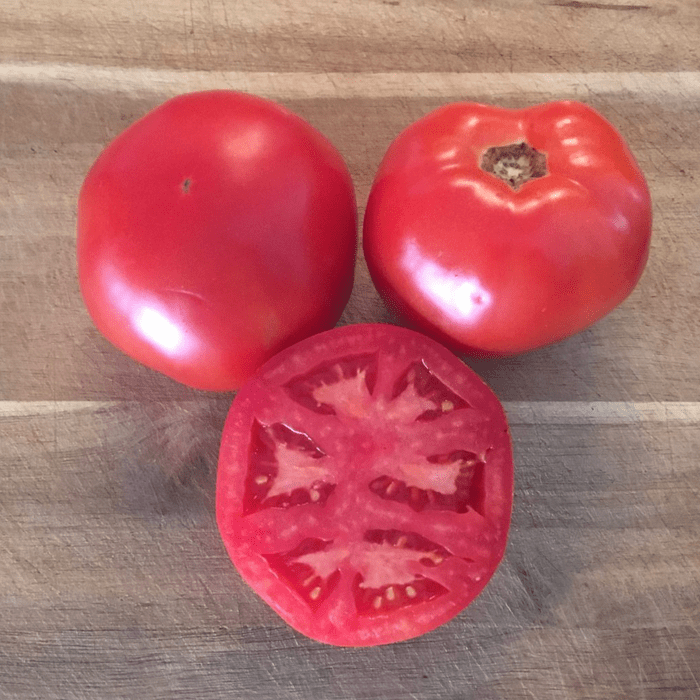
Can’t decide? Try growing both and see which you prefer. Both heirloom and hybrid tomatoes make excellent garden plants. Heirlooms have unbeatable flavors while hybrids offer improved traits like better disease resistance, increased yield, or earlier maturity.
About the Expert
Craig LeHoullier, also known as the NC Tomatoman, is a lifelong gardener, the author of the book Epic Tomatoes and the co-leader of the Dwarf Tomato Breeding Project.
Why Trust Us
For nearly 30 years, Birds & Blooms, a Trusted Media Brand, has been inspiring readers to have a lifelong love of birding, gardening and nature. We are the #1 bird and garden magazine in North America and a trusted online resource for over 15 million outdoor enthusiasts annually. Our library of thousands of informative articles and how-tos has been written by trusted journalists and fact-checked by bird and garden experts for accuracy. In addition to our staff of experienced gardeners and bird-watchers, we hire individuals who have years of education and hands-on experience with birding, bird feeding, gardening, butterflies, bugs and more. Learn more about Birds & Blooms, our field editor program, and our submission guidelines.
On This Page
How to Grow Stock Flowers
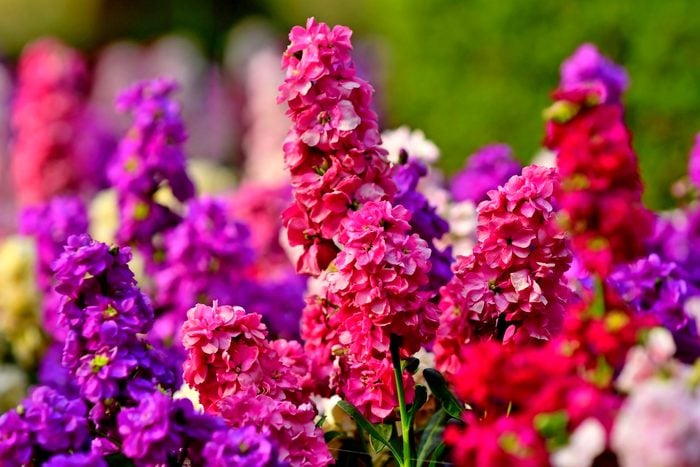
- Common name: Stock flower, Brompton stock, Gillyflower
- Scientific name: Matthiola incana
- Hardiness zones: 7 to 10
- Light needs: Full sun to partial shade
- Watering needs: Average, keep soil consistently moist but not waterlogged
- Preferred soil: well-drained, fertile, pH of 6.0 to 7.5
- Size: 10 to 36 inches tall, 6 to 18 inches wide
- Flower colors: white, pink, purple, lavender, red, yellow, apricot, blue, rose pink, bicolor or multicolor
- Attracts: Bees and butterflies
Spiky, colorful stock flowers are relatively easy to grow and low-maintenance once established, making them a good choice for both new and experienced gardeners. But they do require specific conditions.
“Stock thrive in fertile, well-drained soil,” says Dr. Christine Coker, horticulturist and professor at Mississippi State University. “Good plant nutrition is necessary for better quality; however, high levels of nitrogen can cause weak stems.” They can also be sensitive to potassium deficiency. For this reason, it can be helpful to get a soil test and make necessary amendments before planting.
When and Where to Plant Stock Flowers
Plant stock flowers in full sun in cooler zones or dappled sun in hotter and drier climates. Depending on your preferences, you can grow them from seeds or potted plants. “Starting from seeds gives you a wider variety of options, while starting with potted plants can give you a head start in the growing process,” says Laura Root a horticulturist at Park Seed.
Transplant seedlings or potted plants in early spring, after the last frost, with plenty of space to grow. To encourage longer stems for cut flowers, Christine recommends spacing them on six-inch centers. You can also plant them in the fall for early spring blooms.
“They do well in cool weather and are typically grown as annuals,” says Laura. “However, in warmer climates, they may reseed and act as biennials. They also make great container plants, so you can add them to your garden bed or place them on a patio or balcony.”
Stock Flower Problems
To prevent wilting and stress, stock flowers need consistent moisture levels, and never let them dry out. Use a trellis or other support for taller varieties and regularly deadhead them, removing spent blooms to encourage new growth and prolong blooming.
As for pitfalls, watch out for aphids, thrips and fungal diseases.
Stock Flower Benefits
With their spiky stalks and variety of bright colors, stock flowers make both your garden and home décor come alive. They’re ideal for bouquets, centerpieces, focal flowers and corsages since they last up to two weeks after being cut.
“Stock flowers are renowned for their delightful fragrance, which is often described as a mix of cloves, cinnamon and vanilla,” says Laura. “This sweet and spicy scent makes them popular choices for perfumes and potpourri.”
They can also be used as a garnish, says Christine, though the flowers are bitter. When springtime temperatures begin to rise, they stop producing marketable flowers.
Stock Flower Meaning
They also come rooted in tradition. “In the language of flowers, stock flowers symbolize lasting beauty and a happy life,” says Laura. “They are often included in bouquets for weddings and other celebrations.”
Do Stock Flowers Attract Pollinators?
Some varieties release their fragrance in the evening, attracting nocturnal pollinators like moths and bats. During the day, their bright blooms also help butterflies, bees and other important pollinators.
“By providing a food source for these pollinators, stock flowers can help support a healthy ecosystem in your garden,” says Laura. “Additionally, the flowers themselves can serve as shelter for small insects and other wildlife. Adding stock flowers to your garden can contribute to a more diverse and vibrant environment.”
Stock Flower Varieties
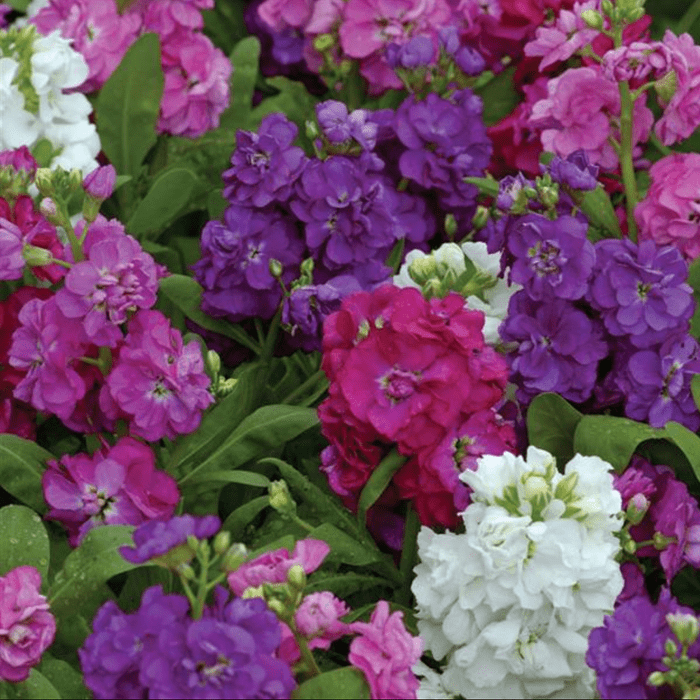
“For cut flower use, I am particularly fond of the Katz Series which is available in apricot, blue, pink, white, purple, rose pink, rose and yellow,” says Christine.
Laura’s top pick is Hot Cakes, an interesting variety known for vibrant and eye-catching blooms in bold colors including deep purple, bright pink or fiery orange. “It produces large, double flowers that add a pop of color to garden beds or floral arrangements,” she says. “They perform best in cool weather and give an excellent fragrance in early spring.”
About the Experts
Laura Root is a horticulturist and senior product manager at Park Seed. She has 12 years of experience in the green industry and holds a degree in environmental horticulture from Virginia Tech University. Plants are her passion, but her joy especially comes from sharing her knowledge with others.
Dr. Christine E.H. Coker is a research and Extension professor of urban horticulture at Mississippi State University’s Coastal Research and Extension Center Beaumont Horticultural Unit. She has more than 20 years of experience sharing her love of plants with gardeners of all skill levels.
Why Trust Us?
For nearly 30 years, Birds & Blooms, a Trusted Media Brand, has been inspiring readers to have a lifelong love of birding, gardening and nature. We are the #1 bird and garden magazine in North America and a trusted online resource for over 15 million outdoor enthusiasts annually. Our library of thousands of informative articles and how-tos has been written by trusted journalists and fact-checked by bird and garden experts for accuracy. In addition to our staff of experienced gardeners and bird-watchers, we hire individuals who have years of education and hands-on experience with birding, bird feeding, gardening, butterflies, bugs and more. Learn more about Birds & Blooms, our field editor program, and our submission guidelines.
On This Page
What Does a Black-and-White Warbler Look Like?
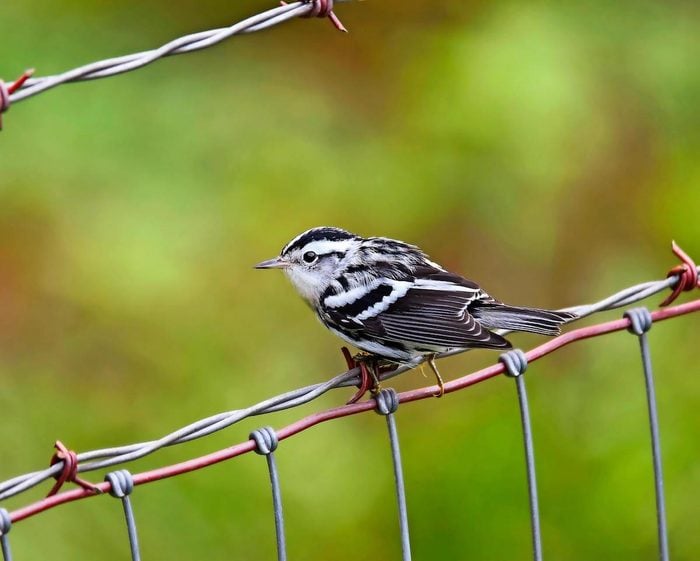
With distinctive, bold black and white stripes from the crown of their head to their tail feathers, the black-and-white warbler is much easier to identify than most other warblers.
“They probably have one of the best names of any warblers,” says Keith Arnold, Professor Emeritus at Texas A&M University.
Keith says the only confusion might involve the blackpoll warbler, yet they are distinguished from the black-and-white warblers by their noticeable black cap and white cheek.
Black-and-white warblers are medium-sized wood warblers between roughly 4 to 5 inches long with a short neck and tail. They have particularly long hind claws to assist them while scurrying along tree trunks. The birds also feature a slightly curved-downward bill that is perfect for plucking insects from the bark and branches of trees.
At first glance, it’s a little trickier telling the males and females apart. The females are generally paler in their markings, plus they have a pronounced white patch on their throat and a grayish ear patch. If you can spot it, the females also have black spots on the undertail feathers between the belly and the tail.
Range and Habitat
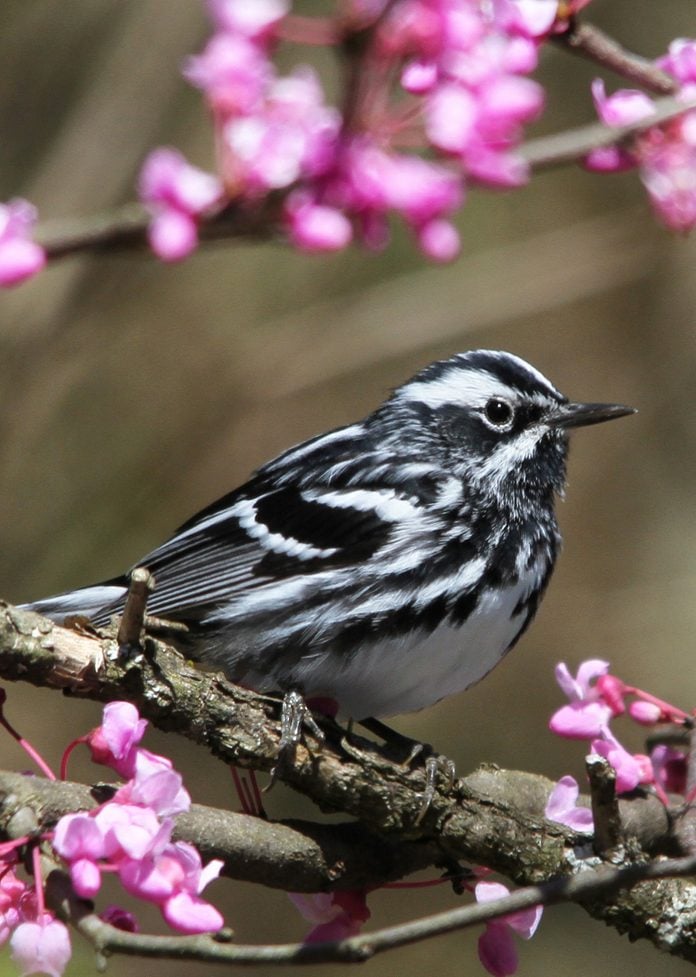
“They are neat little birds, and are widely distributed, as well,” says Keith. “They breed in deciduous and mixed woodlands in the Eastern and Central US and into Canada.” This includes as far southwest as Eastern Texas and stretching into the Northwest Territory during the summer months.
These warblers are considered long-distance migratory birds, and will overwinter in Mexico, Central America, the West Indies and Bahamas, as well as northern South America. And there are reports of some birds spending the winter in California. In many areas, the migration begins in August. They are some of the first to return in the spring, finding their way back to New England and southern Canada by May.
Because they cover extended distances, Keith notes there are high mortality rates every year. “There was a fallout on the coast, and there were 1,400 that died of exhaustion from crossing the Gulf of Mexico,” he notes.
Nesting Habits and Eggs
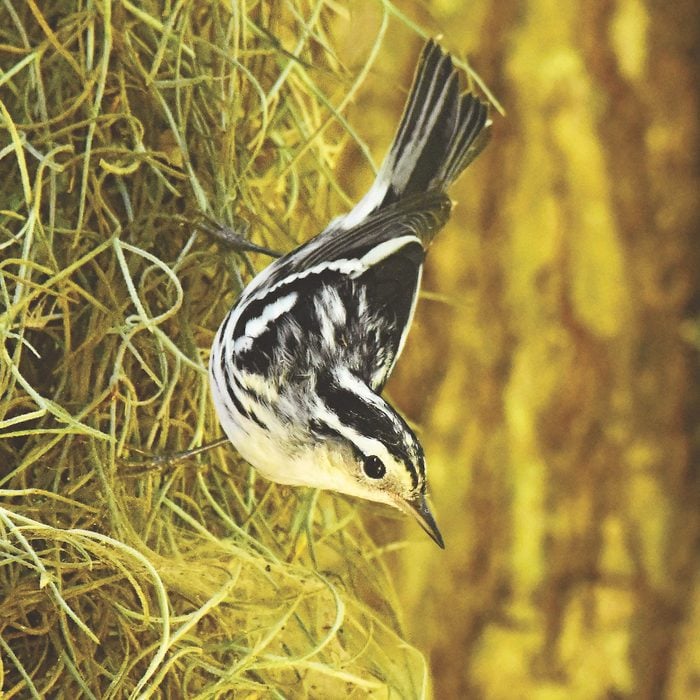
While most other warblers nest in the trees, Keith points out, “They are ground nesters. They build a little cup-shaped nest on the ground, often in a cavity or next to a tree stump.”
Scientists still aren’t certain as to how they build their nests, and whether one or both parents take part in the process. They’re typically constructed of course grasses, dried leaves and pine needles with the softer interior consisting of shredded bark, moss, grass and even horsehair.
Keith notes that they produce one brood a year. The eggs are laid in successive days. Incubation by the female begins when the next to last, or the last, egg is laid, and lasts between 10 and 12 days.
Most of the eggs white or creamy white, although there are some that might have a pale blue or greenish tinge to them. “They are quite variable in the coloration of spots,” he says, noting that they might have fine brown spots, or a pale lavender.
Both the parents tend to the young, which leave the nest between eight and 12 days after they hatch.
What Do Black-and-White Warblers Eat?
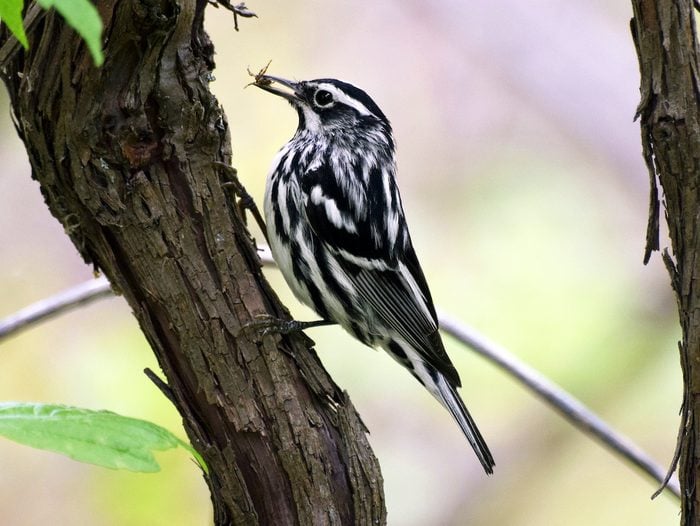
Like nuthatches and brown creepers, you’ll notice black-and-white warblers foraging along the trunk of trees, as well as in the crevices of branches and tips of the limbs looking for caterpillars, beetles, and a wide variety of insects. Their genus name, Mniotilta, means “moss-plucking” because of their tendency to poke around moss and other areas where insects might be hiding.
Because of their insect-focused diet, they’re not interested in seeds. Keith says, “Normally they come into the feeder because they are eating the insects that also come into the feeder.”
One of the best ways to encourage them in your backyard is to have trees, native shrubs and perennials that host the insects black-and-white warblers feed upon.
Black-and-White Warbler Songs and Calls
Bird sounds courtesy of The Cornell Lab of Ornithology
“It’s not very melodic like some of the warblers,” says Keith. This makes them easier to identify in the world of warblers. One of the primary songs of the males is very high-pitched, weesy, weesy, weesy repeated over several seconds. The males lower and vary this pitch during the breeding period when singing to the female.
“They have a little call note that is quite distinctive,” Keith notes. Both the males and females communicate with a series of chits or pits in a sequence.
About the Expert
Ornithologist Keith Arnold is Professor Emeritus at Texas A&M University, the founder of the Texas Breeding Bird Atlas and the Texas Bird Records Committee, as well as a respected author who contributed to the Birds of Texas.
Sources
- Birds of the World – black-and-white-warbler
- All About Birds – black-and-white warbler
- National Audubon Society – black-and-white warbler
- American Bird Conservancy – black-and-white warbler
Why Trust Us?
For nearly 30 years, Birds & Blooms, a Trusted Media Brand, has been inspiring readers to have a lifelong love of birding, gardening and nature. We are the #1 bird and garden magazine in North America and a trusted online resource for over 15 million outdoor enthusiasts annually. Our library of thousands of informative articles and how-tos has been written by trusted journalists and fact-checked by bird and garden experts for accuracy. In addition to our staff of experienced gardeners and bird-watchers, we hire individuals who have years of education and hands-on experience with birding, bird feeding, gardening, butterflies, bugs and more. Learn more about Birds & Blooms, our field editor program, and our submission guidelines.
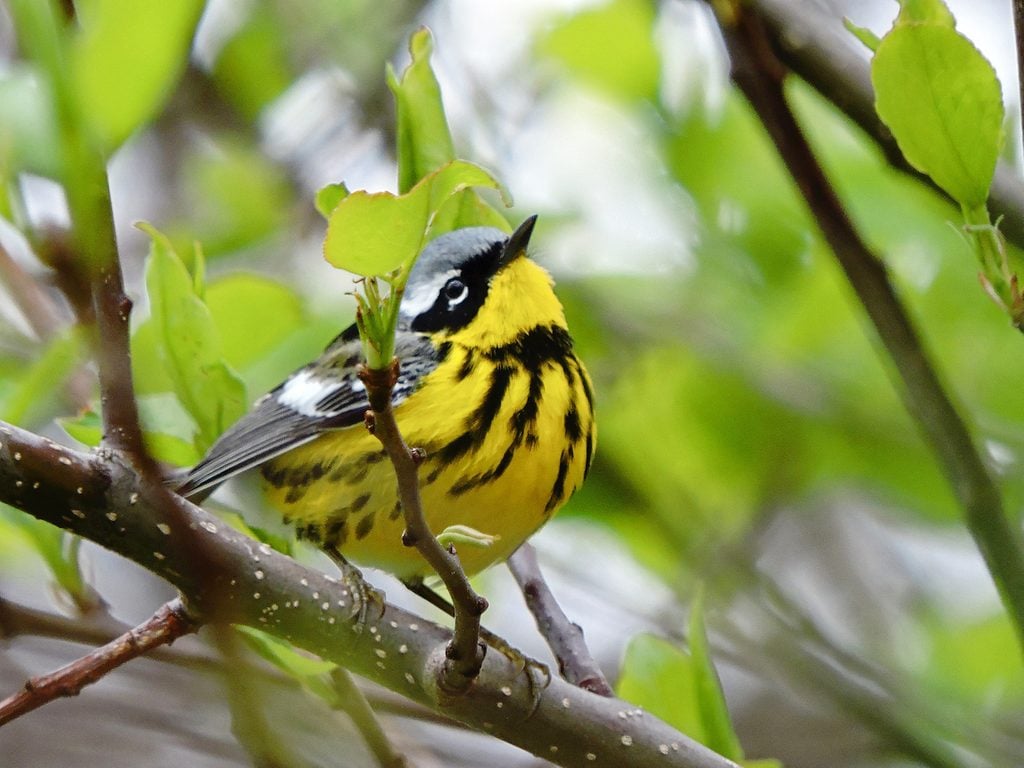
To put it simply–magnolia warblers are just plain cute.
These small, sweet borbs are worthy of adding to your life list on looks alone, though there’s a lot more to these captivating creatures. They’re elusive little ones, which means you’ll want to be strategic when attempting to spot one in the wild.
“They are a great little species, and they are certainly very enigmatic,” said Stacy Hill, an animal keeper in the Bird House at the Smithsonian’s National Zoo & Conservation Biology Institute. “They are always busy in the canopy–and they are really a special bird.”
On This Page
What Does a Magnolia Warbler Look Like?
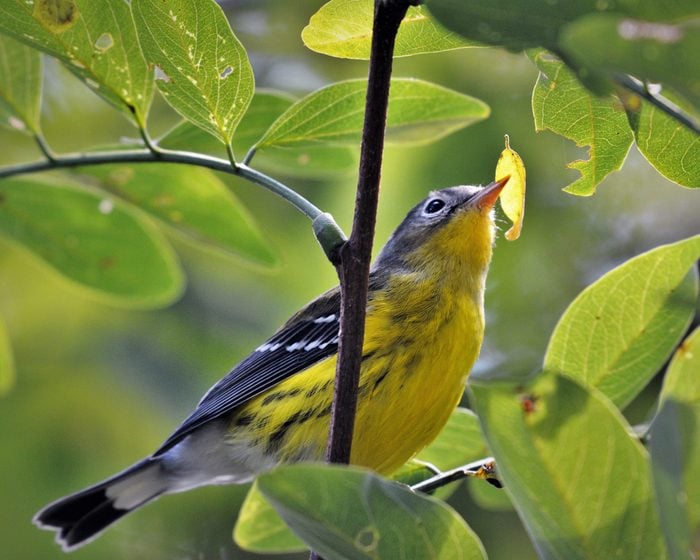
“The magnolia warbler is quite small, with a very notable small, pointy beak. Its primary colors are grey, black and yellow,” said Stacy.
When considering color alone, this small, long-tailed songbird is often confused for Kirtland’s warbler or Canada warbler. And it’s even more confusing as their ranges overlap at times.
The easiest distinguishing feature from other black-and-yellow warblers is its white accents–especially those on its wings and long tail.
“It’s very notable in flight,” said Stacy. Males have striking white accents and a black mask that streaks across its neck and chest. Some birders describe the black markings as looking like a necklace. Females are more muted–mostly grey with smaller white wingbars. Juveniles are primarily grey with black and yellow touches.
Why Is the Bird Called a Magnolia Warbler?
Ornithologist Alexander Wilson named the species in 1810 after discovering it in a magnolia tree in Mississippi, though that’s a misnomer.
“It is a great lovely name,” said Stacy, “but not indicative of what it likes to use for most of its habitat. For a common name it has stuck.”
Magnolia Warbler Habitat and Range
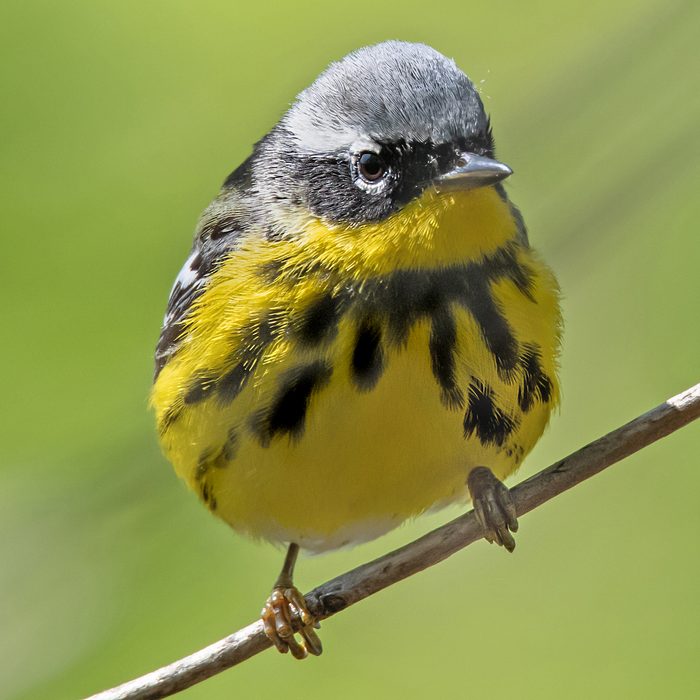
This elusive creature is here and gone quickly.
It only passes through the eastern half of the U.S. on its way from Central America and the Caribbean up to its breeding grounds in Canada–and vice versa. This means we have a narrow window for observation. It travels north between the end of March and early May. Then it returns south between September and November.
Your best chance to catch a glimpse of one is during migration.
Magnolia Warbler Nesting Habits
Those who live up north may discover a breeding pair in the Northeast or near the Great Lakes. They primarily breed in Canada’s dense coniferous, boreal forests of pine and spruce.
Male magnolia warblers arrive in breeding grounds at about the same time as their competitors, and work to establish their territories. To find a mate, he shakes his tail feathers.
“She may return that display,” said Stacy.
Once mated, the pair prepares a cup nest among dense evergreens with loosely-constructed grasses, weeds stalks and twigs lined with horsehair fungus. According to the Smithsonian, female magnolia warblers typically lay three to five eggs per clutch. The eggs are white with multicolored speckles.
Magnolia Warblers Songs and Calls
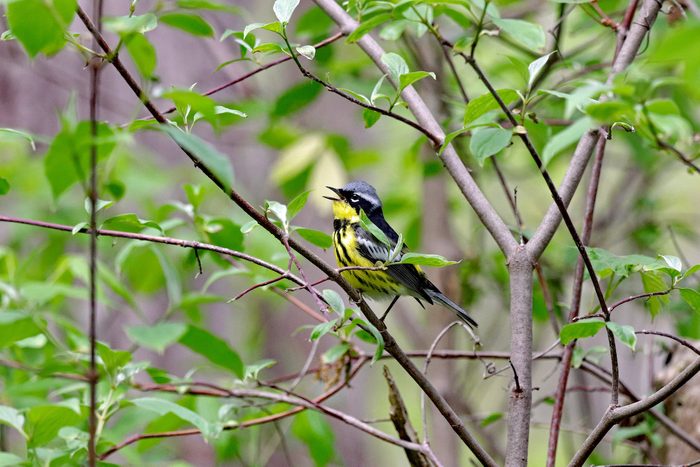
“[Females don’t] necessarily sing,” said Stacy. “There is not a lot of recorded female song in this species.”
What happens after is a mystery. We know the male approaches the female and courts her with his song and dance, though research can still be done to expand upon our knowledge of their courtship behaviors. The size of this bird makes it hard to band and track. And as its conservation status is of least concern, research dollars are limited.
We do know that males have two notable song types–one for territory defense and another communicating with a female.
Bird sounds courtesy of The Cornell Lab of Ornithology
What Do Magnolia Warblers Eat?
Your best bet to spot this songbird is by hiking through your local woods during its migration timeframe. It’s an insect-eater and rarely visits backyards. In spring and summer, they rely heavily on caterpillars and larvae.
To entice one to your backyard, you can try putting our suet or dried mealworms in your feeder. “Provide a lot of native plant species and limit your use of pesticides,” said Stacy.
Draw them in by planting native trees and shrubs to attract the insects and larvae they eat. The songbird occasionally eats fruit or nectar.
Does the Magnolia Warbler Face Any Threats?
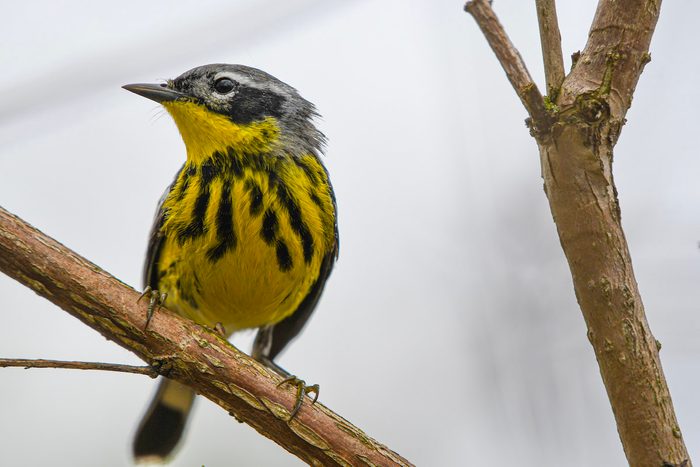
Light pollution disorients many birds, including magnolia warblers, and can cause collisions. “They use stars, the moon and sometimes the earth’s magnetic fields to travel,” said Stacy.
Organizations including the National Audubon Society tout the “Lights Out” program, encouraging people to turn off their outdoor lights at night during peak migration periods.
About the Expert
Stacy Hill is an animal keeper in the Bird House at the Smithsonian’s National Zoo & Conservation Biology Institute. The zoo cares for nearly 80 species of birds in its aviaries, including a breeding pair of magnolia warblers.
Sources
- All About Birds – magnolia warbler
- National Audubon Society – magnolia warbler
- Smithsonian National Zoo & Conservation Biology Institute
Why Trust Us?
For nearly 30 years, Birds & Blooms, a Trusted Media Brand, has been inspiring readers to have a lifelong love of birding, gardening and nature. We are the #1 bird and garden magazine in North America and a trusted online resource for over 15 million outdoor enthusiasts annually. Our library of thousands of informative articles and how-tos has been written by trusted journalists and fact-checked by bird and garden experts for accuracy. In addition to our staff of experienced gardeners and bird-watchers, we hire individuals who have years of education and hands-on experience with birding, bird feeding, gardening, butterflies, bugs and more. Learn more about Birds & Blooms, our field editor program, and our submission guidelines.